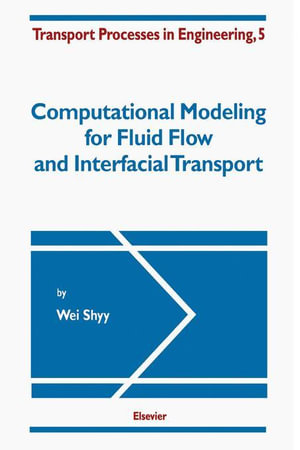
eTEXT
Computational Modeling for Fluid Flow and Interfacial Transport
By: W. Shyy
eText | 22 October 2013 | Edition Number 1
At a Glance
eText
$511.98
Instant online reading in your Booktopia eTextbook Library *
Read online on
Not downloadable to your eReader or an app
Why choose an eTextbook?
Instant Access *
Purchase and read your book immediately
Read Aloud
Listen and follow along as Bookshelf reads to you
Study Tools
Built-in study tools like highlights and more
* eTextbooks are not downloadable to your eReader or an app and can be accessed via web browsers only. You must be connected to the internet and have no technical issues with your device or browser that could prevent the eTextbook from operating.
Both macroscopic and microscopic (but still continuum) features are addressed. In order to lay down a good foundation to facilitate discussion of more advanced techniques, the book has been divided into three parts. Part I presents the basic concepts of finite difference schemes for solving parabolic, elliptic and hyperbolic partial differential equations. Part II deals with issues related to computational modeling for fluid flow and transport phenomena. Existing algorithms to solve the Navier-Stokes equations can be generally classified as density-based methods and pressure-based methods. In this book the pressure-based method is emphasized. Recent efforts to improve the performance of the pressure-based algorithm, both qualitatively and quantitatively, are treated, including formulation of the algorithm and its generalization to all flow speeds, choice of coordinate system and primary velocity variables, issues of grid layout, open boundary treatment and the role of global mass conservation, convection treatment and convergence. Practical engineering applications, including gas-turbine combustor flow, heat transfer and convection in high pressure discharge lamps, thermal management under microgravity, and flow through hydraulic turbines are also discussed.
Part III addresses the transport processes involving interfacial dynamics. Specifically those influenced by phase change, gravity, and capillarity are emphasized, and both the macroscopic and morphological (microscopic) scales are presented. Basic concepts of interface, capillarity, and phase change processes are summarized to help clarify physical mechanisms, followed by a discussion of recent developments in computational modeling. Numerical solutions are also discussed to illustrate the salient features of practical engineering applications. Fundamental features of interfacial dynamics have also been illustrated in the form of case studies, to demonstrate the interplay between fluid and thermal transport of macroscopic scales and their interaction with interfacial transport.
Read online on
ISBN: 9781483290416
ISBN-10: 1483290417
Published: 22nd October 2013
Format: PDF
Language: English
Publisher: Elsevier S & T
Edition Number: 1
You Can Find This eBook In
This product is categorised by
- Non-FictionEngineering & TechnologyMechanical Engineering & MaterialsMechanical Engineering
- Non-FictionEngineering & TechnologyMechanical Engineering & MaterialsMaterials ScienceMechanics of FluidsHydraulics & Pneumatics
- Non-FictionSciencePhysicsClassical MathematicsFluid Mechanics
- Non-FictionMathematicsApplied Mathematics
- Non-FictionEngineering & TechnologyTechnology in General
- Non-FictionEngineering & TechnologyBiochemical Engineering
- Non-FictionSciencePhysics
- Non-FictionEngineering & TechnologyMechanical Engineering & MaterialsMaterials Science























